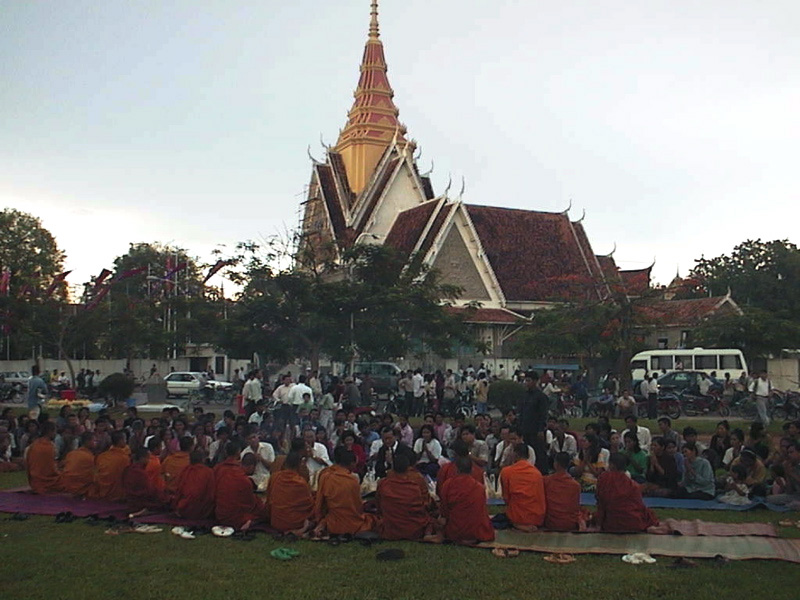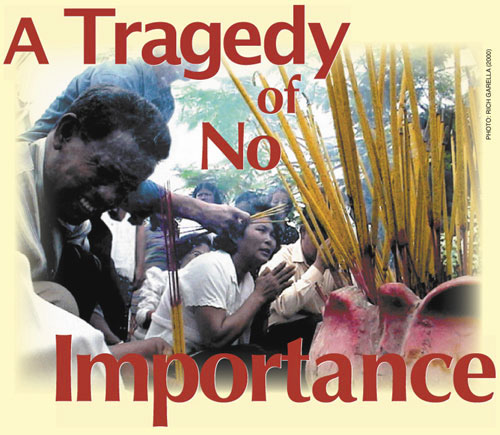Contents
About A Tragedy of No Importance
This article was researched and written by Rich Garella and Eric
Pape. Both of us lived in Cambodia at the time of the grenade attack and
came to know many of the people affected by it. We saw what happened to
the ambitious effort to bring democracy and development to Cambodia,
and learned how the West chooses, finances and inoculates its winners,
and what happens when it abandons its losers.

PHOTO: RICH GARELLA
ON MARCH 30, 1997, about 200 of Rainsy’s supporters gathered to demand a cleanup of the corrupt justice system.
From the party’s offices they marched under the canopy of trees
shading quiet Street 240, past the Kantha Bopha children’s hospital and
the stable of the royal elephants. They emerged, under the baking
morning sun, in a rectangular park in the heart of Phnom Penh.
The park serves as a good map of the past decade of Cambodian politics. Immediately north,[n]
the golden walls of the Royal Palace sheltered Prince Ranariddh’s
father, the revered but politically diminished King Norodom Sihanouk. To
the northeast the Ministry of Justice stands as a mildewed memorial to
the dream of a global union française.
 | |
PHOTO: RICH GARELLA
| |
| National Assembly in 2000 |
To the east, across Sothearos Boulevard from the site of the protest,
the central spire of the ornate National Assembly building rises above
overlapping gables in the Cambodian style. In the center of the park is a
towering statue of a Vietnamese soldier, a Cambodian soldier, and a
woman and child. And on the west side, beyond the boddhi trees,[n] is the Buddhist temple Wat Botum. A complex of mansions and guarded compounds, including one owned by Hun Sen,[n] sprawls out behind it.
A vendor was selling cubes of hand-cut sugarcane from a bright blue wooden pushcart.[s]
A passerby recognized a policeman with whom he had played soccer and
greeted him. “Something is going to happen,” the officer warned him.[s]
Across the park, in front of Wat Botum, a line of soldiers—Hun Sen’s
elite bodyguard unit—stood in formation, armed with AK-47 rifles and
B-40 rocket launchers. Perhaps because it was so early on a Sunday
morning, none of the young Western reporters were there yet.[n]
Abney had stopped off for breakfast. By the time he arrived,
Rainsy, standing on a chair, was wrapping up his speech. Abney started
across the street to greet him. He didn’t notice that the policemen had
pulled back, nearly out of sight. Abney heard a pop, like a bottle being
smashed, and he fell.
Those standing nearest took it in the legs. Metal cut through
flesh, muscle, bone. The center of the crowd flattened out. Han Mony,
Rainsy’s bodyguard, knocked his boss down and fell on top of him[s] just as a second grenade exploded
a few yards away. People were flayed alive as they dived for cover
behind fallen bodies. Fragments sliced through the windshield of a truck
carrying medicinal wine.
The third grenade exploded near the sugar cane cart where the
crowd was thickest, butchering garment factory workers, vendors, and
onlookers, splintering the cart and partially shattering a thick
concrete park bench. The fourth landed on a dirt pathway behind the
crowd, rolled to a stop, and detonated.[n] “It was out of a Kubrick movie,” Abney recalled. “People were flat on the ground, blown to shit.”[s]
Against the sudden silence, moans rose thinly in the air. Two
young women lay near the cart, one with her feet blown off. The other,
pale from blood loss, clutched at a motorcycle taxi driver’s shirttails,
begging for help. A 13-year-old boy, Ros Keam, lay clutching a protest
sign, his arms and legs pierced by shrapnel. Bodies lay scattered on the
pavement like broken puppets. Rainsy’s wife, Tioulong Saumura, heard a
woman screaming, “Your husband is dead! Your husband is dead!”[s]
As the smoke thinned, a few members of the National Assembly
slowly emerged and wept at the sight, accompanied by a surreal
combination of sounds: the slow, careful steps of late-arriving
photographers, the fading wails of the mortally wounded, and the pockets
of silence in between. An American journalist paced the sidewalk,
speaking into a cell phone, her voice cracking. “It’s horrible. It’s
horrible.”[s]
Within a few minutes, policemen began to arrive. Ignoring the
wounded protesters, they roped off the area and removed loudspeakers
left over from the rally. The woman with no feet sat up. “Hot…hot,” she
murmured, as her eyes began to glaze.
 | |
PHOTO: DARREN WHITESIDE (ASIAWEEK)
|
The motorcycle taxi driver picked up one of the wounded girls, but a soldier told him to put her down, or die.[s] Helpless, he left her under a tamarind tree and stood by the palace wall, saying to himself, “She is dying, she is dying.”[s]
For thirty-five minutes no ambulances arrived.[s]
When they finally did, Phnom Penh’s three main hospitals became
obstacle courses of sprawling victims and slick pools of blood. The
truck driver’s head was delivered to the morgue in a cardboard box.



No comments:
Post a Comment